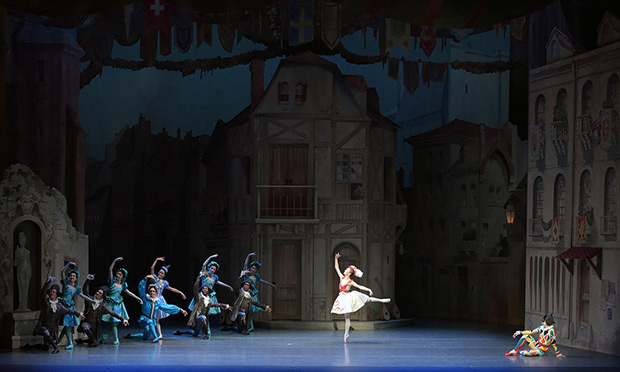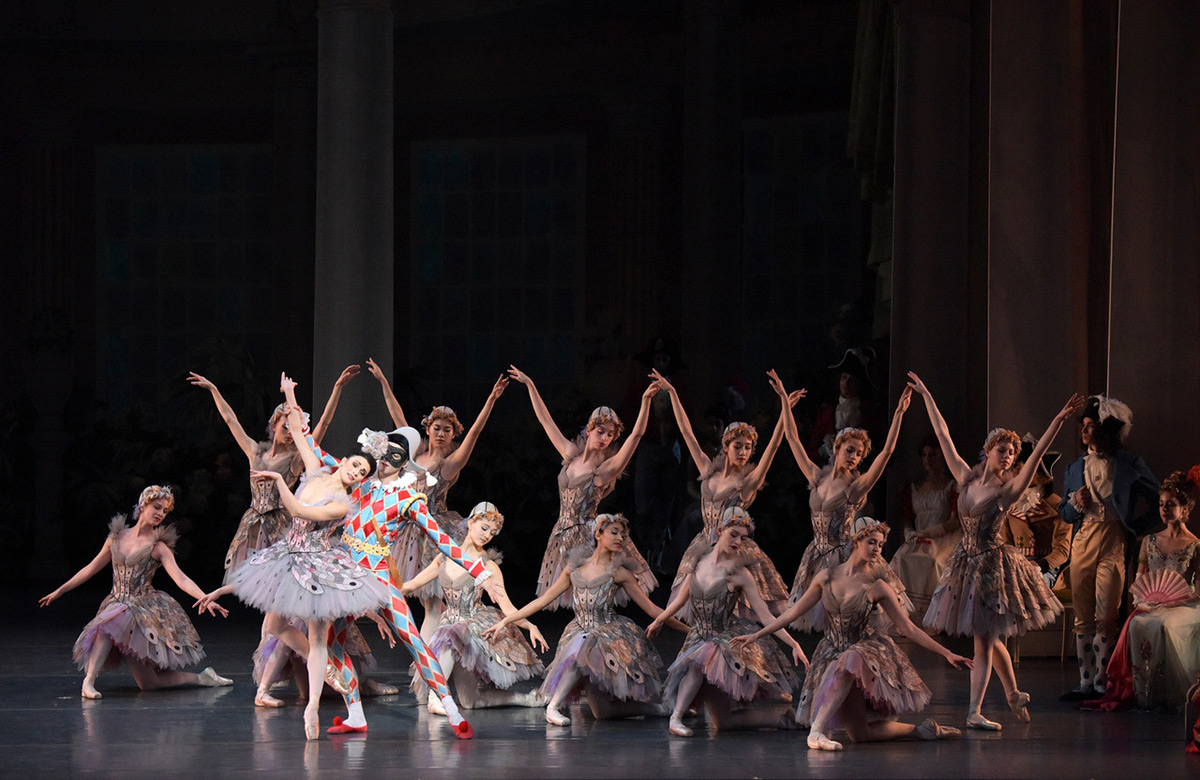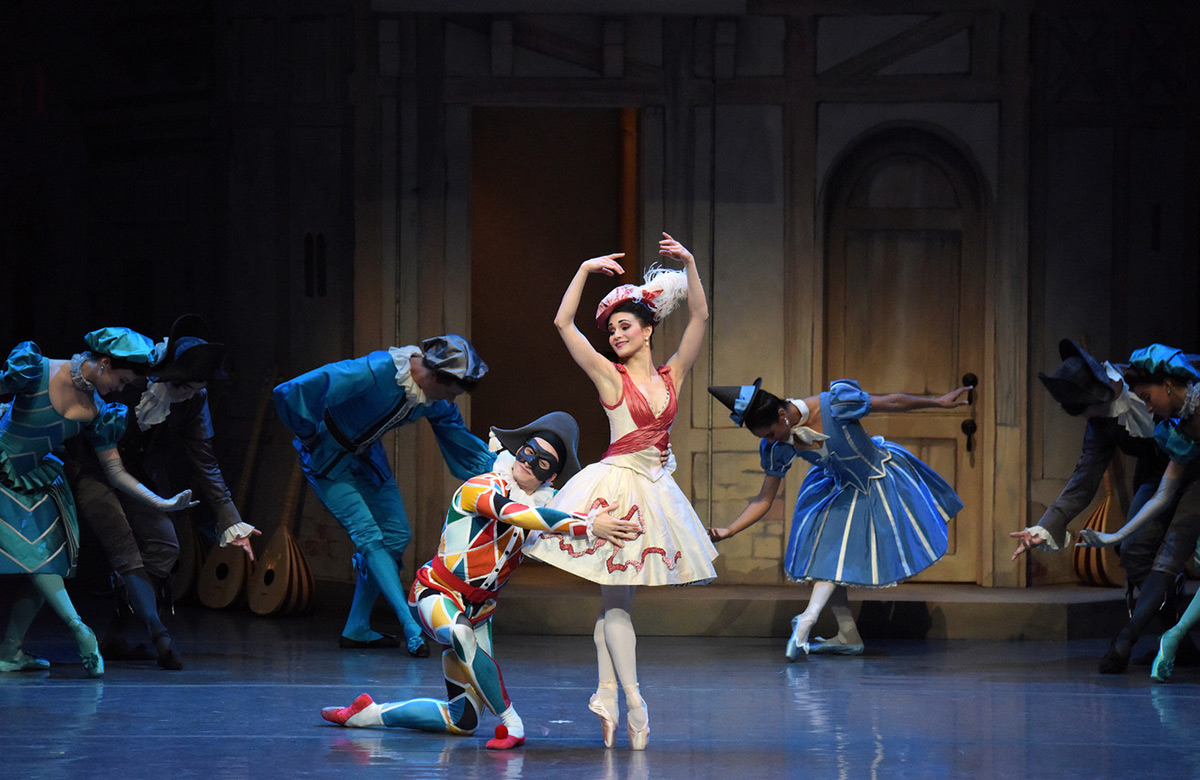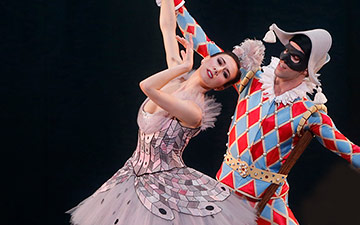
© Doug Gifford. (Click image for larger version)
American Ballet Theatre
Harlequinade
★★★★★
New York, Metropolitan Opera House
17, 18 June 2019
www.abt.org
www.metopera.org
Harlequin’s Serenade
Alexei Ratmansky’s “reconstruction” of Marius Petipa’s 1900 ballet Harlequinade opened American Ballet Theatre’s spring season this week. This is Ratmansky’s tenth anniversary with the company; as he recently said in an interview, it is the longest he has lived anywhere since leaving for ballet school in Moscow in the late seventies. In Harlequinade, we can see how this extended acquaintance has begun to flower in earnest. The dancers now breathe his style; it has become their natural habitat. They dance with their whole bodies and imaginations; their backs and arms and faces sing, while their legs and feet move with speed and precision. To my eye, this Harlequinade may be the most well-rounded of his historically-minded stagings of Petipa. It is all of a piece; the dancing, storytelling, designs, and costumes (by Robert Perdziola) exist in harmony and equilibrium. The company shines. And, though it is based on early twentieth-century notations of Petipa’s steps, the production feels alive and of the moment, as if it had been choreographed yesterday. One senses that it is as much a product of Ratmansky’s imagination as it is of Petipa’s.
To recap, these “reconstructions” of Petipa are stagings for which Ratmansky, like an early-music specialist, has gone back to historical sources in order to recreate Petipa’s choreography as faithfully as possible. In the case of Harlequinade, there are boxes of scores written out in Stepanov Notation (held at Harvard), as well as photographs, first-hand descriptions, and an invaluable film of Tamara Karsavina rehearsing the first-act mime. Not everything is notated, of course; entire passages, like a double pas de deux in the first act (for Columbine, Harlequin, Pierrette, and a cavalier) had to be rebuilt from scant evidence. Others, like Olga Preobrazhenska’s original first-act Columbine solo, are almost intact. But there are no jarring contrasts. More than that, one senses that the whole ballet has been brought back to life through the imagination and sensibilities of a choreographer working, as it were, by Petipa’s side. The mime speaks; the dancing has flavor and specificity of style; the characters are vivid and full of life.
The key to Harlequinade is charm; the entire ballet feels like a throwback to an earlier theatrical world of pantomimes and refined, delicate entertainments. None of the characters are meant to represent real people; they’re whisper-thin characters drawn from the commedia dell’arte canon. Harlequin is a scamp; Columbine a lighthearted and tender young woman; Pierrette, her faithful and charming servant and partner-in-crime. Léandre, a favorite of mine, is a ridiculous upper-class fop, like Gamache in Don Q. The stories have much in common, as does Coppélia, for that matter. In many ways, they’re all versions of the same situation.

© Doug Gifford. (Click image for larger version)
The music, by Riccardo Drigo, is light, melodic, incredibly catchy – in fact several of the sections, like Harlequin’s “Serenade” became popular songs at the beginning of the century. This “Serenade” scene is one of the loveliest in the ballet, and in many ways encapsulates the way Petipa builds rhythm and momentum: At first, Harlequin and a group of friends sing a serenade in 3/4 under Columbine’s window. As the violin melody rings out, the dancer performing Harlequin moves his lips as if singing. He looks up at the balcony and “tells” the audience that there lives a beautiful girl he is madly in love with. She appears at the window, delighted at the sound of the music. She mimes back that she cannot come down because she is locked in, but then is set free by Pierrette. She runs down, and filled with delight, begins to dance with Harlequin, joined by Pierrette and an unnamed cavalier. This leads into the double pas de deux I mentioned before, in which one couple mirrors and embroiders on the other’s steps, while four couples echo them. More dances follow, including the devilishly hard Preobrazhenska solo, in which Columbine hops on one leg while the other travels from front to back, then executes a dancing diagonal of cabriole-to-sauté-to-piqué steps. All this happens in a seamless wave of music, or rather a series of small waves flowing into each other. Musicality, humor, charm, all rolled up into one.
As an aside, my one complaint is that the Metropolitan Opera House is too big for this ballet; some of its intimacy and warmth is lost in the vast space onstage and between the stage and the audience. It would read twice as well in a smaller theater.
In the second act, the slight story finds its resolution with a wedding at the beginning of the act, followed by joyous dancing. This act also contains one of the ballet’s four major ensemble pieces, a giant polonaise involving the whole cast. The steps are simple – just a polonaise step, over and over – but the patterns, all of them devised by Petipa, are ingenious: lines, squares, curves, diagonals, semi-circles. You find yourself admiring both its simplicity and its complexity. This is followed by a children’s ensemble in which groups of kids dressed as commedia characters emerge one after another, each performing a combination of ballet steps and mime: the boys tap on the girls’ shoulders, causing them to jump; the miniature Pierrots try to kiss the Pierrettes. They hold the stage completely to themselves, creating a world of beautifully-prepared and highly capable children.
The festivities conclude with the most beautiful set piece of all, an allegory for love in the form of a lark hunt (Harlequin is the hunter, Columbine the lark). It contains several of the ballet’s most striking and poetic images: a moment in which Columbine-as-lark leans against Harlequin’s back as he slides down into a low lunge, an image of total trust. A strange and stirring unfolding of the leg as Columbine leans deeply to the side, creating a soft and vulnerable shape. Several lifts in which her body is curved like a crescent moon; and a final, impressive, behind-the back, one-handed fish dive.

© Doug Gifford. (Click image for larger version)
It turns out that this ballet is not so simple after all; it contains some very serious dancing indeed, embedded in a structure so charming that it seduces you into thinking it’s just fun and games. I saw two casts, on Friday and Saturday evenings. Both included dancers new to the role of Harlequin, Carlos Gonzalez on Friday and Tyler Maloney on Saturday. (They’ve performed the ballet out of town, but never in New York.) Gonzalez was more lyrical, almost romantic. Maloney captured the character’s mix of creaturely “otherness” and child-like delight. The mask distances us from the character; the pom-pommed hat augments the bobbing moves of his head. Both dancers acquitted themselves well in the highly complex beaten steps, so reminiscent of Bournonville’s choreography; I found Maloney’s mime particularly engaging, comic without being broad. The two Columbines, Sarah Lane (Friday) and Cassandra Trenary (Saturday) were even more different. Lane was the more reserved and refined of the two, and exhibited a remarkable control, holding certain balances for an extra beat so that they would register even more, and rolling down off pointe with gorgeous articulation. Trenary was particularly vivid and engaged in the mime scenes; she’s an effective actress. I particularly loved a detail she added in the serenade, in which she indicated how much she loved the sound of the mandolin, miming the gesture of playing the instrument herself. Her dancing had a less lyrical, brighter cast, and she and Maloney had a wonderfully lively rapport. Devon Teuscher’s Pierrette was seductive, clever; Christine Shevchenko’s more uniformly sunny. Everyone danced with sensitive musicality. As Léandre, the foppish older suitor, Keith Roberts gave a convincingly ridiculous, highly detailed performance.
But in reality, this is a ballet in which the whole cast is essential to creating the right tone and spirit. If the ensemble looks unengaged or bored – as so often happens in stagings of Petipa ballets – the whole soufflé goes flat. That never happened here, and this is the joy of the production and of the manner in which it has been staged. It has conviction. The fantasy world created onstage, from start to finish, is brimming with life.

















You must be logged in to post a comment.